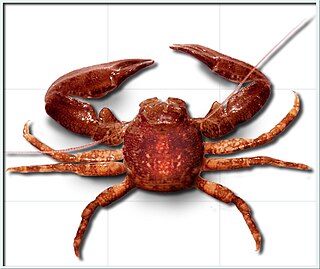
Paratrechina is one of seven ant genera in the Prenolepis genus-group from the subfamily Formicinae. Six species are included in Paratrechina; one of which, the longhorn crazy ant, is a widespread, pantropical pest.

Pisidia longicornis, the long-clawed porcelain crab, is a species of porcelain crab that lives in the north-eastern Atlantic Ocean. It varies from reddish to white, and grows to a carapace width of 1 cm (0.4 in). It was first named by Carl Linnaeus in 1767, although the etymology remains unclear.

The longhorn crazy ant, also known as the black crazy ant, is a species of small Formicine ant. These ants are commonly called "crazy ants" because instead of following straight lines, they dash around erratically. They have a broad distribution, including much of the tropics and subtropics, and are also found in buildings in more temperate regions, making them one of the most widespread ant species in the world. This species, as well as all others in the ant subfamily Formicinae, cannot sting. However, this species can fire/shoot a formic acid spray from its abdomen when under attack by other insects or attacking other insects. When the longhorn crazy ant bends its abdomen while aiming at an enemy insect, it is typically shooting its hard-to-see acid.
Copelatus longicornis is a species of diving beetle. It is part of the genus Copelatus in the subfamily Copelatinae of the family Dytiscidae. It was described by Sharp in 1882.

Hemilophini is a tribe of longhorn beetles of the subfamily Lamiinae.
Isomerida is a genus of longhorn beetles of the subfamily Lamiinae, containing the following species:
Isomerida apiratinga is a species of beetle in the family Cerambycidae. It was described by Martins and Galileo in 1992. It is known from Peru.
Isomerida ibitira is a species of beetle in the family Cerambycidae. It was described by Martins and Galileo in 1992. It is known from Brazil.
Isomerida tupi is a species of beetle in the family Cerambycidae. It was described by Martins and Galileo in 1992. It is known from Brazil and Colombia.
Isomerida invicta is a species of beetle in the family Cerambycidae. It was described by Galileo and Martins in 1996. It is known from Peru.
Isomerida paraiba is a species of beetle in the family Cerambycidae. It was described by Galileo and Martins in 1996. It is known from Brazil.
Isomerida santamarta is a species of beetle in the family Cerambycidae. It was described by Galileo and Martins in 2001. It is known from Colombia.
Isomerida sergioi is a species of beetle in the family Cerambycidae. It was described by Galileo and Martins in 2009. It is known from Bolivia.
Isomerida cinctiventris is a species of beetle in the family Cerambycidae. It was described by Henry Walter Bates in 1885. It is known from Panama and Costa Rica.
Isomerida lineata is a species of beetle in the family Cerambycidae. It was described by Henry Walter Bates in 1874. It is known from Brazil, Bolivia, Colombia, Nicaragua and Peru.
Isomerida albicollis is a species of beetle in the family Cerambycidae. It was described by Laporte in 1840. It is known from Brazil, French Guiana and Colombia.
Isomerida amicta is a species of beetle in the family Cerambycidae. It was described by Francis Polkinghorne Pascoe in 1866. It is known from Colombia and Panama.
Isomerida lanifica is a species of beetle in the family Cerambycidae. It was described by Ernst Friedrich Germar in 1824. It is known from Brazil.
Isomerida vittata is a species of beetle in the family Cerambycidae. It was described by Francis Polkinghorne Pascoe in 1859. It is known from Brazil.

Spilomyia longicornis is a species of syrphid fly, also known as a flower fly or hoverfly, in the family Syrphidae. Although the appearance of S. longicornis is remarkably similar to a vespid wasp, it is a fly and cannot sting. It occurs in North America, east of the Rocky Mountains.



